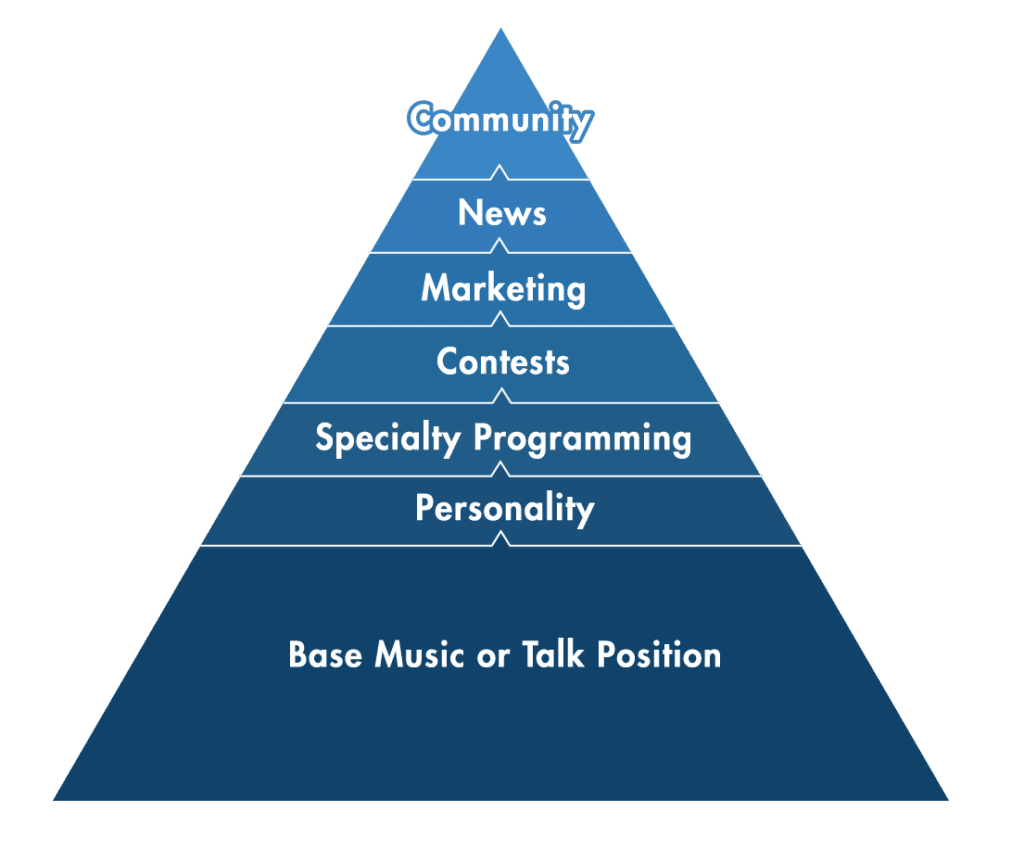
This is the story of a once-dominant radio station that did everything right.
The owners deployed a perceptual research (Plan DeveloperSM) study on the brand every single year to ensure its market position was the most optimal one. It had an enviable Image PyramidSM: a strong Base Music Position, a dominant morning show that complemented the brand, and deep images that permeated the community.

The Coleman Insights Image Pyramid
Because this station consistently fielded research, we saw things that were not obviously there. Ratings were great. Revenue was great. But there was trouble brewing, and we could identify it early.
For obvious reasons, we can’t share identifying information such as the market, station, and personalities, but we invite you to take a look back at the progression of studies done for this brand over a nearly fifteen year period to get a clearer glimpse of how the process works–and how valuable perceptual research can be.
At one time, our client station was in an outstanding position. Their perceptual research looked very strong. It was strongly associated with its desired music images and the morning show was the dominant leader in the market. In fact, in the early stages of research, our morning show was growing with Cume and P1 listeners and there were few signs of weakness.
Then a new competitor launched. It wasn’t the first time our station had fended off competitors. If ratings and revenue were the measure of success, the client station was still in an outstanding place. The new competitor was on a weak signal, which limited its potential. But early on, despite what ratings showed, the morning show on the new competitor displayed positive early indicators in our research. And, despite what the ratings said, we saw the first signs of image erosion with our show.
About a year later, it was clear the crosstown morning show showed impressive promise with the younger end of our target demographic. We recommended attempting to acquire the other morning show.
Eleven months later, our morning show still performed well in the ratings, but there was a clear disconnect with the younger end. At this point, our station had a far stronger Base Music Position and in fact the competitor’s base position was weakening. But their morning show was growing and was wildly popular among their P1s. Their show was not performing to its potential because that station’s Base Music Position was weak. Again, we recommended making a play for the other show.
A year later, the weakness of our competitor’s music position continued to hamper their morning show, which lacked familiarity in the market. But the show was outperforming our show perceptually on the younger end. We believed, particularly because of its weak music position, getting this show would be devastating to the other station. We once again recommended going after it.
Another year later: We insisted a morning show change needed to be made. The host of the other show had been given the time needed to develop into a superstar. Our show’s fan base was now significantly older than the target of our station. But by this point, making a pitch for their show was getting out of reach.
Two years later: Our station’s perceptual position had eroded. Cume Conversion (the percentage of listeners that convert into loyal P1s) plummeted. Momentum images were concerning, with a high number of listeners that felt our station was “not as good as it used to be.” By this point, our morning show was replaced, but it was too late–and the new morning show was not a good fit and had high negative images.
Three years later: The competitor was now the preferred station in our target demographic. The other show was in syndication.
The station has arguably never recovered, going through a variety of format shifts and talent lineups while the competitor continues to thrive.
Every good researcher will tell you that their job isn’t to tell you what you want to hear–it’s to tell you what you need to hear, as we did here. And fortunately, we often get to deliver good news–but hearing bad news can be immensely valuable. It would be easy to say, “Why didn’t they just make the change??”…but of course it’s more complicated than that, including money issues and people issues. It’s hard to pull the trigger on something when ratings and revenue show things are going well.
By deploying strategic research, you get to see things that aren’t immediately obvious. You get to make the decisions that can have remarkable impacts on your brand. It’s certainly better than relying on ratings and gut alone.
